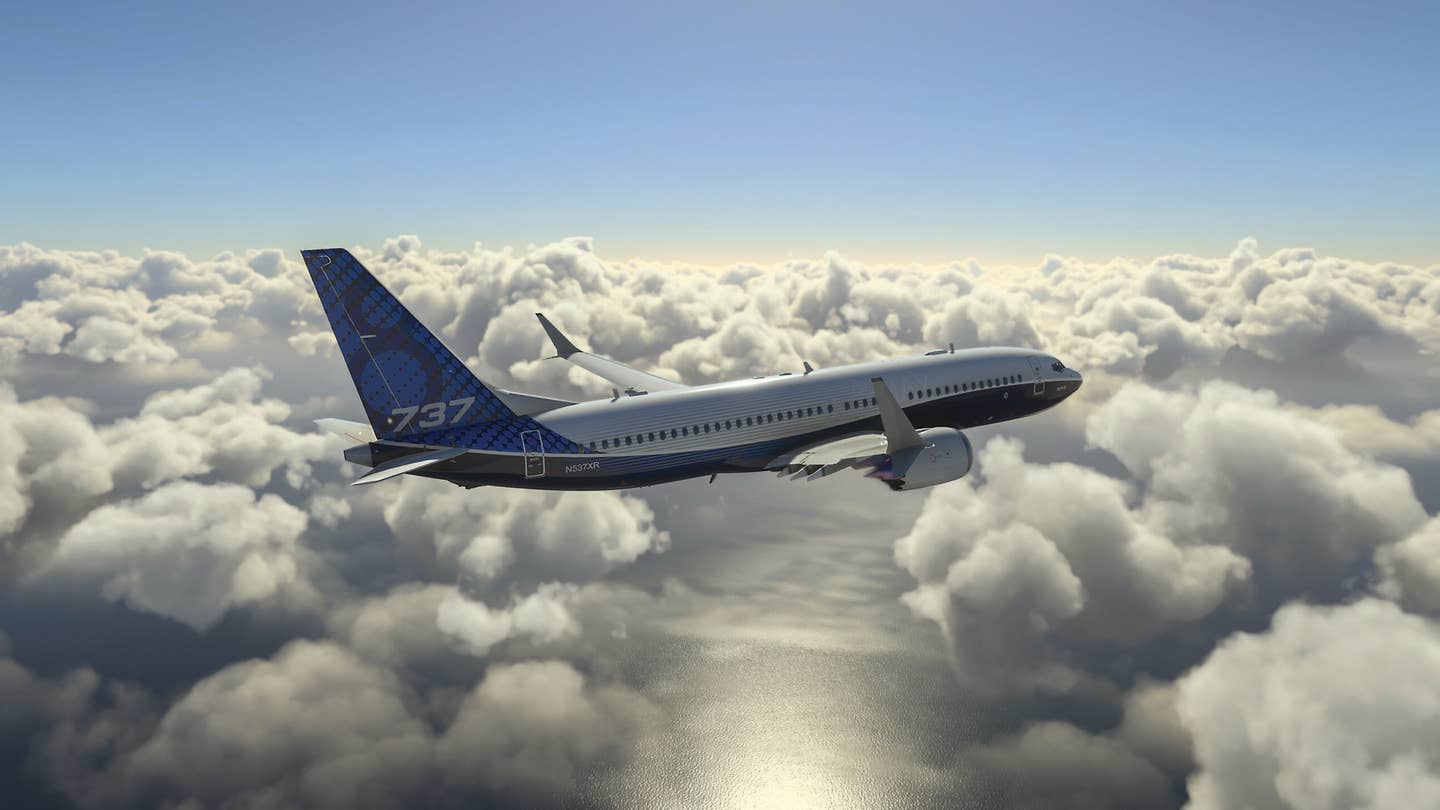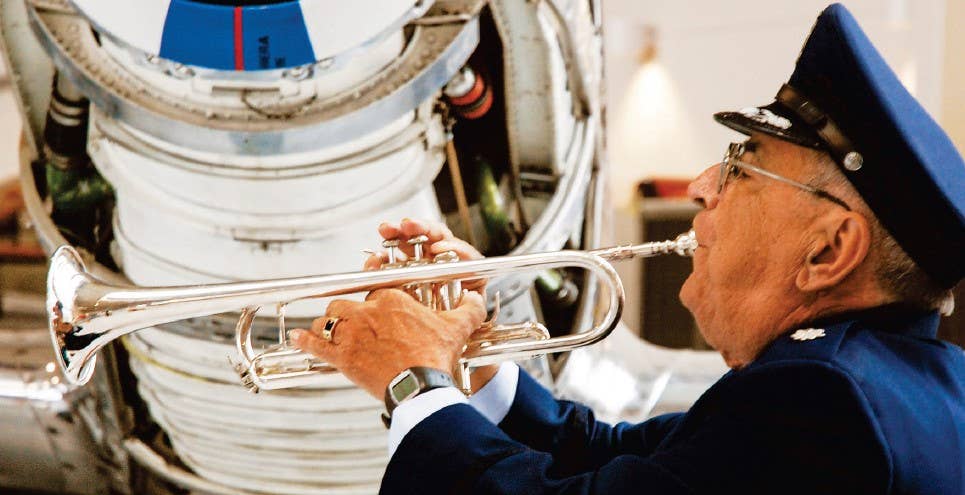Taking Wing: Beyond the Uniform
Military or civilian pilot, after a few years the differences fade.

A commercial Boeing 737 Max 8 flies to Sao Paulo in 2022. [Adobe Stock]
I had just finished entering our route from Seattle to Phoenix into the Boeing 737’s flight management system when John clattered down the jet bridge with his Rollaboard, thumped onto the jet, and entered the cockpit with a cheerful greeting. “Hey, great seeing you again!” I welcomed my first officer du jour. “What’s it been, three or four months?” In reality, though I recognized John and was pretty certain I enjoyed flying with him, I could not for the life of me recall a single detail of our last trip, or even about his background. In normal work life this would no doubt be an embarrassing faux pas, but in the airline world, and particularly at a large base like Seattle 737, it’s an entirely common experience and little reason for discomfiture. As John settled into the right seat and started building his nest, he readily admitted he had equally little memory of me or of our trip, and we set about reconstructing our knowledge of each other. (“Oh, wait, you’re the guy who lived on a sailboat, right?”)
If you're not already a subscriber, what are you waiting for? Subscribe today to get the issue as soon as it is released in either Print or Digital formats.
Subscribe NowI half-joked that if John was younger and more junior, I could probably guess with reasonable accuracy whether he was a “McChord C-17,” “Whidbey P-3,” or “Whidbey Growler” guy. This is because even though military pilots make up less than half of my airline’s new hires for the first time in our history, they comprise a surprisingly high percentage of the newbies in the Seattle 737 base. I attribute this to the presence of multiple nearby Air Force and Navy Reserve units, which allow pilots who have recently separated from active duty to continue to fly for the military part-time, building toward the 20 years of service that merits a government retirement and healthcare. The largest of these is the Air Force’s 446th Airlift Wing, with three squadrons of C-17s at McChord AFB in Tacoma, Washington. Up at Naval Air Station Whidbey Island, there are three Navy Reserve squadrons: VP-69 (until recently flying the Lockheed P-3 Orion, now converted to the Boeing P-8A Poseidon), VAQ-209 (EA-18G Growler), and VR-61 (Boeing C-40A Clipper).
My limited claim to omniscience perked up John’s attention and he demanded, with a grin, that I take a stab at his background. I knew he was retired military, but his demeanor offered few clues to branch, base, or aircraft. I guessed McChord C-17 and was wrong; in fact, John spent 20 years flying and teaching on P-3s for the Navy and Navy Reserve. But he also spent years in Boeing Flight Test and has been at our airline for six years, which is more than enough to blur the differences not only between military branches and communities but also between military and civilian pilots. Molded by our various backgrounds and experiences, time spent in the airline’s culture tends to erode the edges of all but a few particular individuals.
There was a time, when I was quite young, that my bedroom was adorned with F-16 posters and I had aspirations of military flying. At 12 years old, I was disabused of the notion by an Air National Guard recruiter who noted my substandard eyesight—in those days before LASIK acceptance—barred me from a flight slot in every branch. No matter; I committed to the civilian path and stuck with it.
I had little contact with military aviators at the regional airlines. Horizon had a few Vietnam-era guys on the cusp of retirement, and they were a wild-and-wooly lot even in their dotage. At Compass almost everyone was civilian, but my initial simulator training partner, Rich Metcalf, was a former Air Force F-15C driver who hadn’t touched an airplane in eight years. He had never flown a transport category jet, nor a multicrew airplane, nor one with a glass cockpit or flight management system. Yet for all that, he was magnificent, arguably the sharpest training partner I’ve had in a happy procession of excellent ones.
The major airlines, by their hiring practices, gave credence to the popular notion that military selection and training produced superior pilots, and in Rich I seemed to find terrible confirmation of my inherent inferiority. But then, six years later, I was hired at my current airline, where 95 percent of the captains I flew with were former military aviators. I was startled to find just how similar they were to the pilots I’d known in my decade at the regional airlines. Some were very sharp, others less so; some had natural flying ability, others were wooden; many were kindhearted souls, a few were loudmouthed boors. Every single one made mistakes I’d seen a dozen times before, mistakes I’d made myself. These folks were not superhuman at all; they were working pilots like me. Relieved of my lingering sense of inferiority, I got along famously with almost all these captains and really enjoyed hearing stories of the Ronald Reagan-era military: chasing Russian subs during the Cold War, intercepting TU-95s off the Aleutian Islands, landing on a heaving carrier deck in a typhoon. Often these captains, so used to flying with birds of their own feather, were quite interested to hear my own stories of dark, anxious nights spent alone in the thrumming cocoon of an ancient, overloaded Piper Navajo.
Every once in a while, I’d fly with someone who had never really left the service in their own mind, whose whole identity and ego were wrapped up in their past as a military aviator (most often in the single-seat fighter community). Such captains occasionally earned themselves a private eye roll, but for the most part I indulgently peppered them with questions about their past, to which they predictably rose like a choice trout to a well-presented fly. I received hours of entertaining, most certainly embellished tales out of the deal, plus more than a few free layover beers.
Once I upgraded to captain, I continued to fly with many military pilots, but now they were mostly my age or younger and had been hired within the last few years. Unlike the mostly peacetime Reagan-era captains, these folks spent much of their adult lives at the pointy end of the two-decade “global war on terror.”
The differences are interesting: The egos are smaller, even among fighter jocks, there’s a great deal more diversity, and there’s much more skepticism about the military’s role in the world—and more frank discussion about the highs and lows of service life. I am constantly impressed by the high quality of our new hires, both military and civilian. With rare exceptions, they are extremely sharp individuals and great cockpit companions. They make my job easy. The military pilots, in particular, must learn a great deal in their first months at the airline, especially if they haven’t been flying transport category or multicrew aircraft. Most are very quickly up to speed. I’ve come to realize the airlines’ preference for military aviators isn’t because they’re necessarily superior pilots but because they are predictably trainable in stressful environments. They are used to “drinking through a fire hose.”
A year or two into these pilots’ airline careers, it’s increasingly difficult to tell what branch they came from, even if they continue to fly in the reserves. Another year later, you can’t tell them apart from the civilians. The military pilots have relaxed while the civilians have added some spit and polish. After a few years, most everyone has drifted to a happy medium, which is on the whole a quite good standard—and a big part of the airlines’ enviable safety record the past two decades.
Speaking of which, during our flight to Phoenix, John and I had a eureka moment in which we recalled the details of our previous trip. It was the day of the Christmas bomb cyclone I wrote about in the March issue, with historically terrible weather in Boston, Detroit, and Seattle. John was a fantastic first officer that day, but his cool competence in tough conditions was so utterly normal to my experience that it didn’t make him particularly memorable. This is a great credit not only to John but to all the excellent first officers, military and civilian, with whom I ply the nation’s skies every week. As I near the top third of the seniority list, these folks coming up behind me are becoming the backbone of our airline, remolding our culture in their image. It is a very heartening thing to see.
This column first appeared in the July 2023/Issue 939 print edition of FLYING.

Subscribe to Our Newsletter
Get the latest FLYING stories delivered directly to your inbox







